Used Cars Improved the Creating More Attractive Options for Buyers Seeking Value and Quality
At Market.us News, we strive to bring you the most accurate and up-to-date information by utilizing a variety of resources, including paid and free sources, primary research, and phone interviews. Our data is available to the public free of charge, and we encourage you to use it to inform your personal or business decisions. If you choose to republish our data on your own website, we simply ask that you provide a proper citation or link back to the respective page on Market.us News. We appreciate your support and look forward to continuing to provide valuable insights for our audience.
Table of Contents
Introduction
According to Used Cars Statistics, The used car market, influenced by economic conditions, technological advancements, and shifting consumer preferences, is witnessing significant growth globally.
Factors such as economic fluctuations and advancements in automotive technologies drive consumer purchasing behavior, with online marketplaces and certified pre-owned programs gaining traction.
Moreover, the rise of electric and hybrid vehicles, along with regulatory changes, presents both challenges and opportunities for industry stakeholders.
Despite supply chain disruptions and the emergence of mobility-as-a-service platforms, the used car market remains dynamic, offering cost-effective alternatives and meeting the diverse transportation needs of consumers worldwide.
Editor’s Choice
- The global used car market revenue is projected to reach 3.1 trillion dollars by 2033.
- It is projected that by 2027, the market ratio of pre-owned to new cars will rise to 1.9 in India.
- In 2020, the distribution of the pre-owned car market across various sectors in India exhibited a diverse landscape. Customer-to-customer transactions accounted for the largest share at 34%, indicating a significant portion of sales occurring directly between individual consumers.
- In May 2020, the sales performance of used cars in the U.S. showed significant variations among the top models in the market. The Honda HR-V led the rankings with a remarkable year-over-year increase of 53.10% and an 88.80% rise from the previous month.
- In May 2020, the used car market in the U.S. displayed a diverse range of trends across different price points when compared to the previous year and the preceding month. Cars priced at $5,000 saw a positive trend, with a 7.10% increase year-over-year and a 43.70% rise from the previous month.
- The survey reveals that Great Britain leads among the countries studied, with approximately four-fifths of its population expressing openness to purchasing pre-owned cars, totaling 81%.
- In the United States, older consumers show a higher inclination towards buying second-hand vehicles, with 82% of individuals over 55 expressing openness to this option, compared to 56% of 18-24-year-olds.
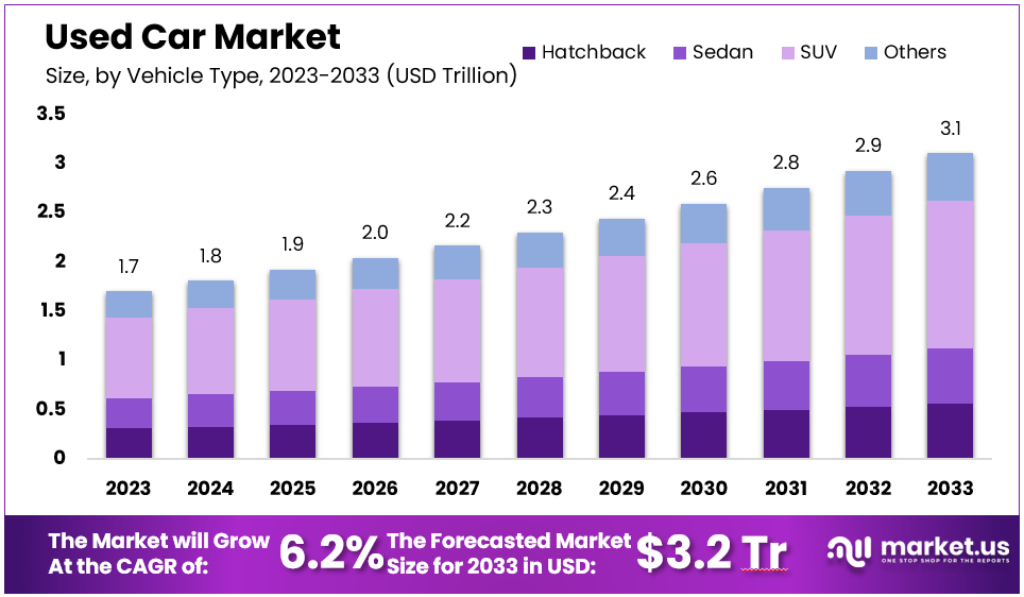
Global Used Car Market Overview
Global Used Car Market Size
- The global used car market is projected to experience steady growth in revenue over the next decade at a CAGR of 6.2%.
- In 2023, the market revenue stands at 1.7 trillion dollars. It is anticipated to increase to 1.8 trillion dollars in 2024 and further to 1.9 trillion dollars in 2025.
- The upward trend continues, with the revenue reaching 2.0 trillion dollars in 2026 and 2.2 trillion dollars by 2027.
- The growth trajectory is set to steepen as the revenue is forecasted to hit 2.6 trillion dollars in 2030, 2.8 trillion dollars in 2031, 2.9 trillion dollars in 2032, and finally 3.1 trillion dollars by 2033.
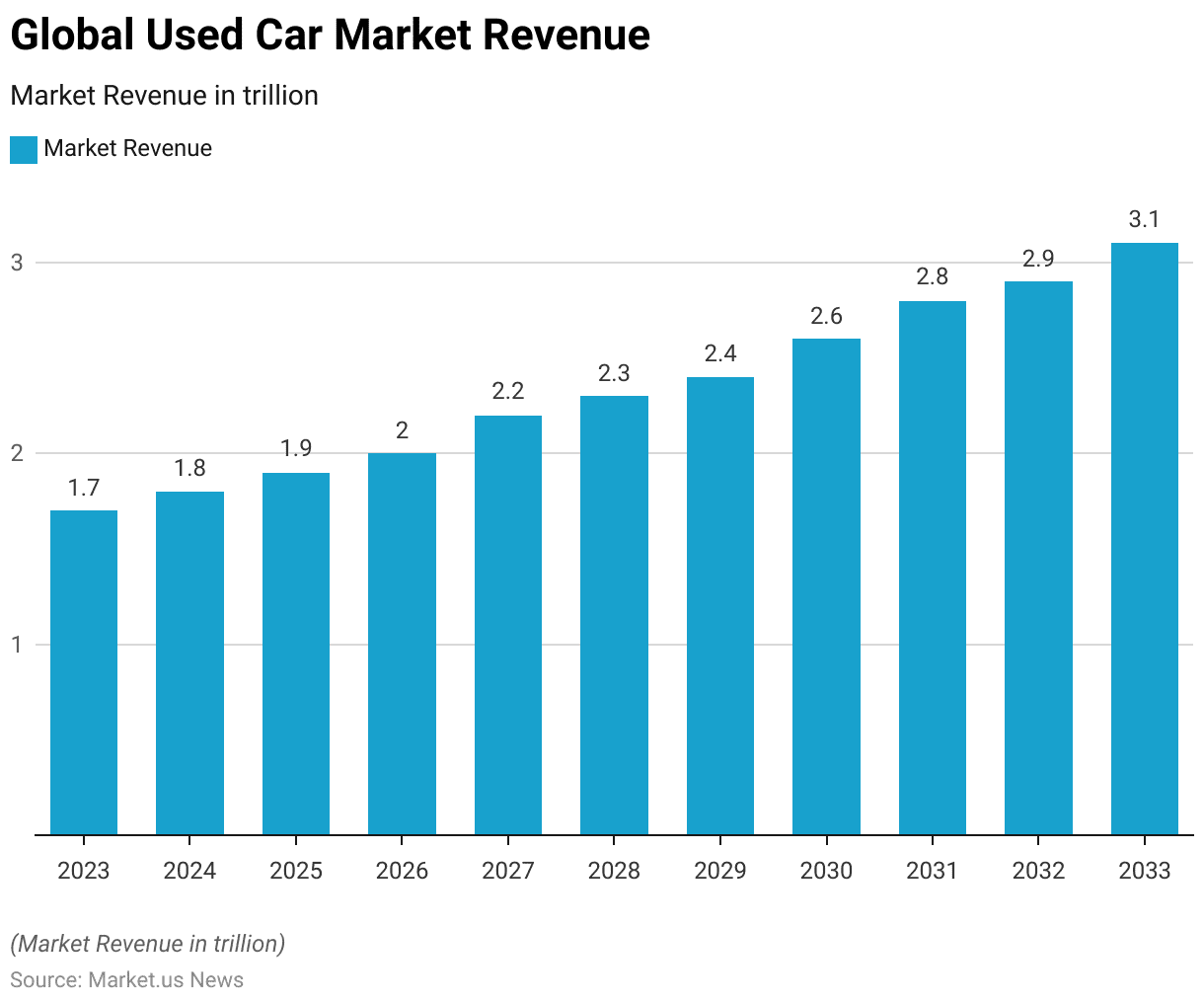
Market Ratio of Pre-owned to New Car
- From the financial year 2016 to 2022, the market ratio of pre-owned to new cars in India exhibited a notable trend.
- Between 2016 and 2019, the ratio remained stable at 1.2, indicating that for every new car sold, approximately 1.2 used cars were sold. This pattern of stability suggests a consistent consumer preference for pre-owned vehicles during these years.
- However, a significant change occurred in 2020, when the ratio increased to 1.5, reflecting a greater shift towards used cars.
- Looking ahead, it is projected that by 2027, the market ratio of pre-owned to new cars will rise to 1.9.
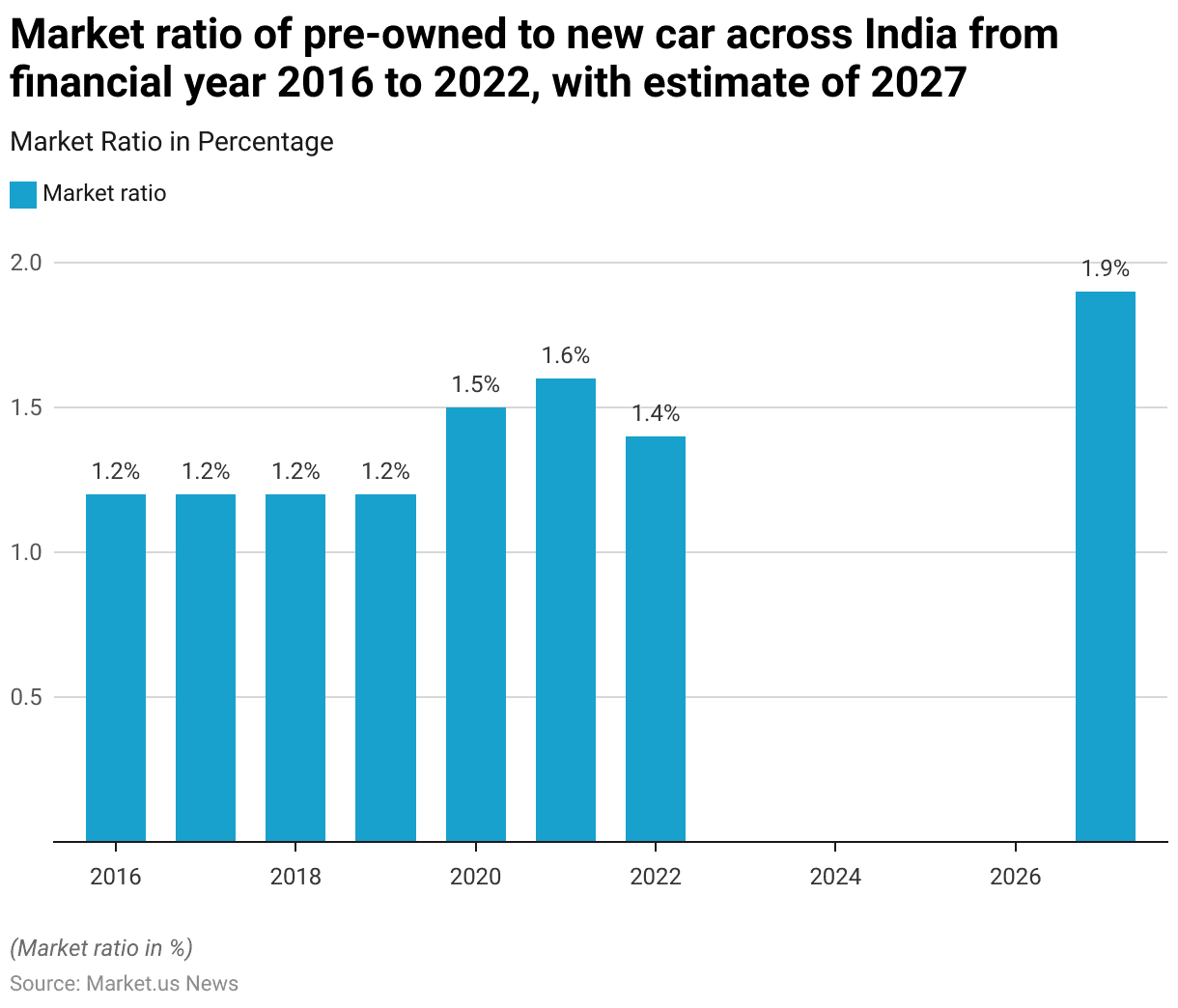
Distribution of Pre-Owned Car Market by Sector
- In 2020, the distribution of the pre-owned car market across various sectors in India exhibited a diverse landscape.
- Customer-to-customer transactions accounted for the largest share at 34%, indicating a significant portion of sales occurring directly between individual consumers.
- Semi-organized sectors followed closely, representing 27% of the market, suggesting a notable presence of dealerships and small-scale businesses facilitating pre-owned car transactions.
- The organized sector comprised 21% of the market, indicating the involvement of established dealerships and certified pre-owned programs.
- Meanwhile, the unorganized sector accounted for 18% of the market, reflecting a segment characterized by informal sales channels and individual sellers operating outside of established structures.
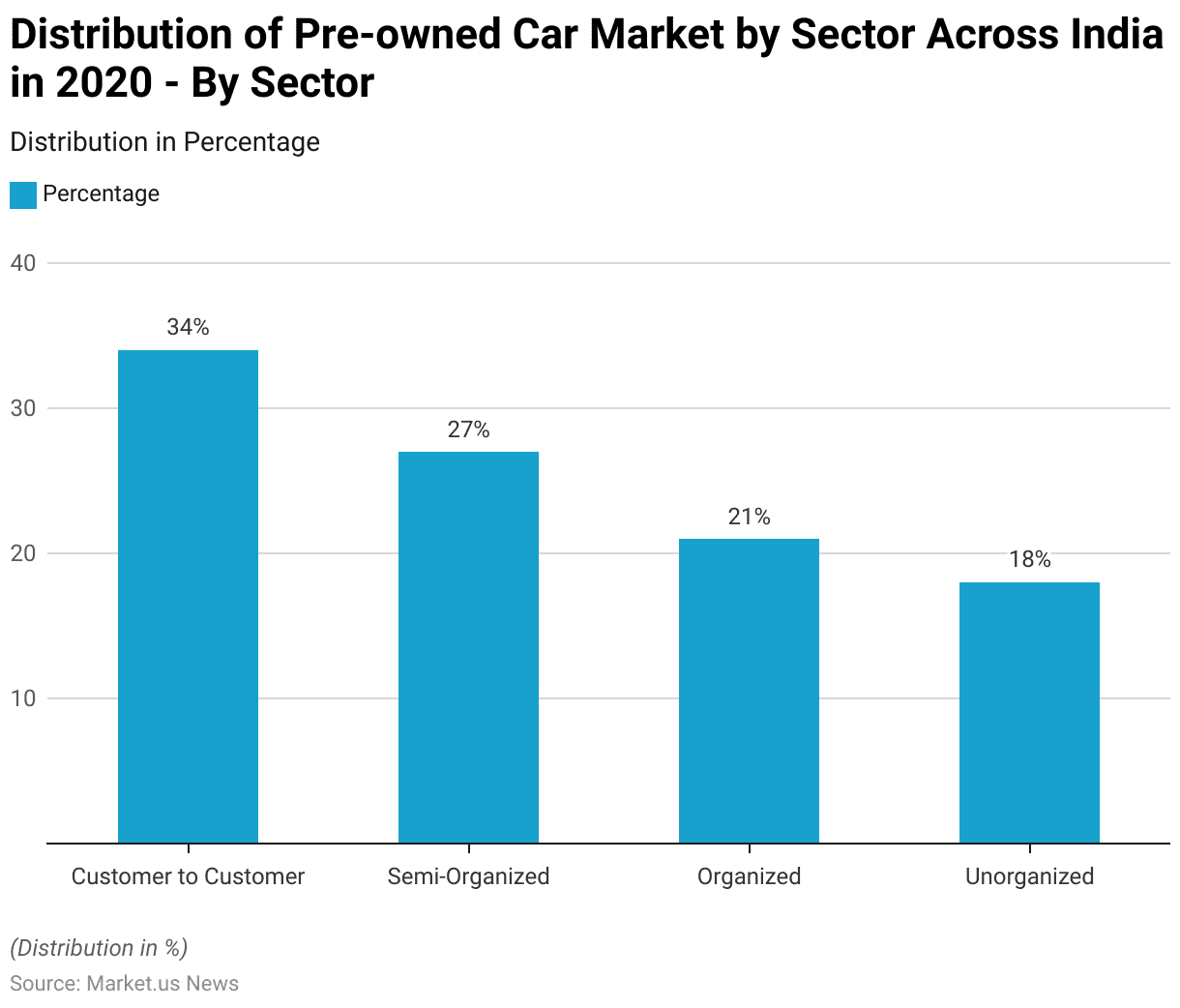
Used Car Sales Statistics
Model
- In May 2020, the sales performance of used cars in the U.S. showed significant variations among the top models in the market.
- The Honda HR-V led the rankings with a remarkable year-over-year increase of 53.10% and an 88.80% rise from the previous month. Following closely, the Cadillac XT5 secured the second position, exhibiting a 37.90% increase compared to the same period last year and a 46.00% growth from the month before.
- The Volkswagen Passat ranked third, saw a 29.00% increase year-over-year and a substantial 71.20% surge from April 2020. The Chevrolet Trax came in fourth with a 23.90% year-over-year increase and a 59.30% rise from the previous month.
- The Jeep Compass, in the fifth spot, showed a 17.70% growth from last year and a 41.90% increase from the previous month. The Nissan Rogue Sport followed, with a 14.80% increase year-over-year and a 44.80% rise month-over-month.
- The Mercedes-Benz GLC experienced a 14.10% increase from last year and a notable 94.90% jump from April 2020.
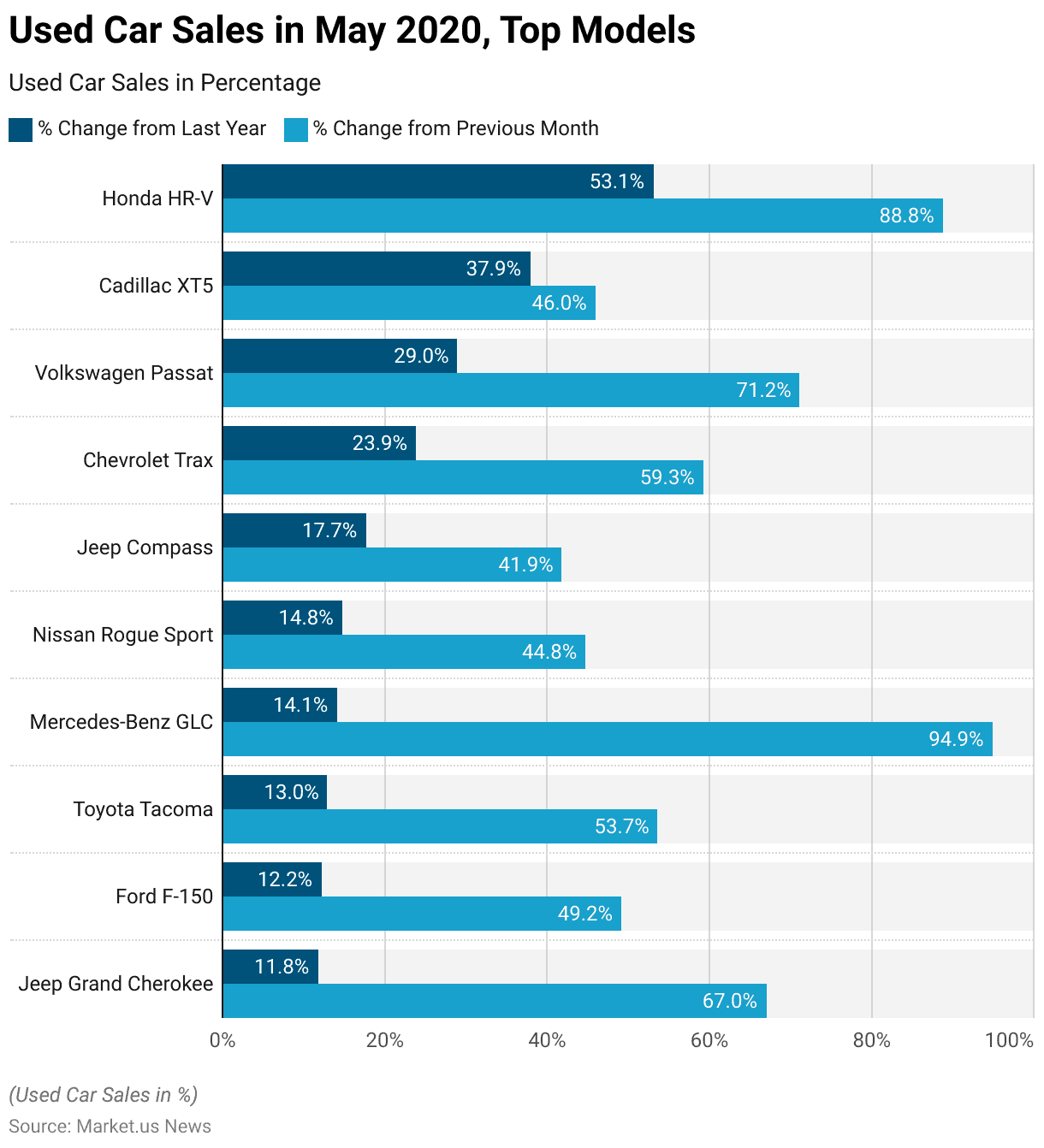
Bodystyle
- In May 2020, in the U.S., the used car sales data by body style revealed diverse trends in performance compared to the previous year and the preceding month.
- Convertibles saw a decline of 9.50% from the previous year but experienced a rebound of 30.30% over the prior month.
- Similarly, coupes also faced a year-over-year decrease of 9.60%, though they showed a modest recovery with an 18.40% increase from April 2020.
- Hatchbacks reported a significant drop of 26.30% year-over-year, yet they managed a notable rise of 44.10% from the previous month.
- Minivans saw a decrease of 19.70% compared to last year but increased by 51.70% over the previous month. In contrast, pickup trucks displayed a positive trend with a 9.40% increase year-over-year and a 46.90% rise month-over-month.
- Sedans continued the pattern of declines with a decrease of 18.90% year-over-year but surged by 57.80% from April 2020.
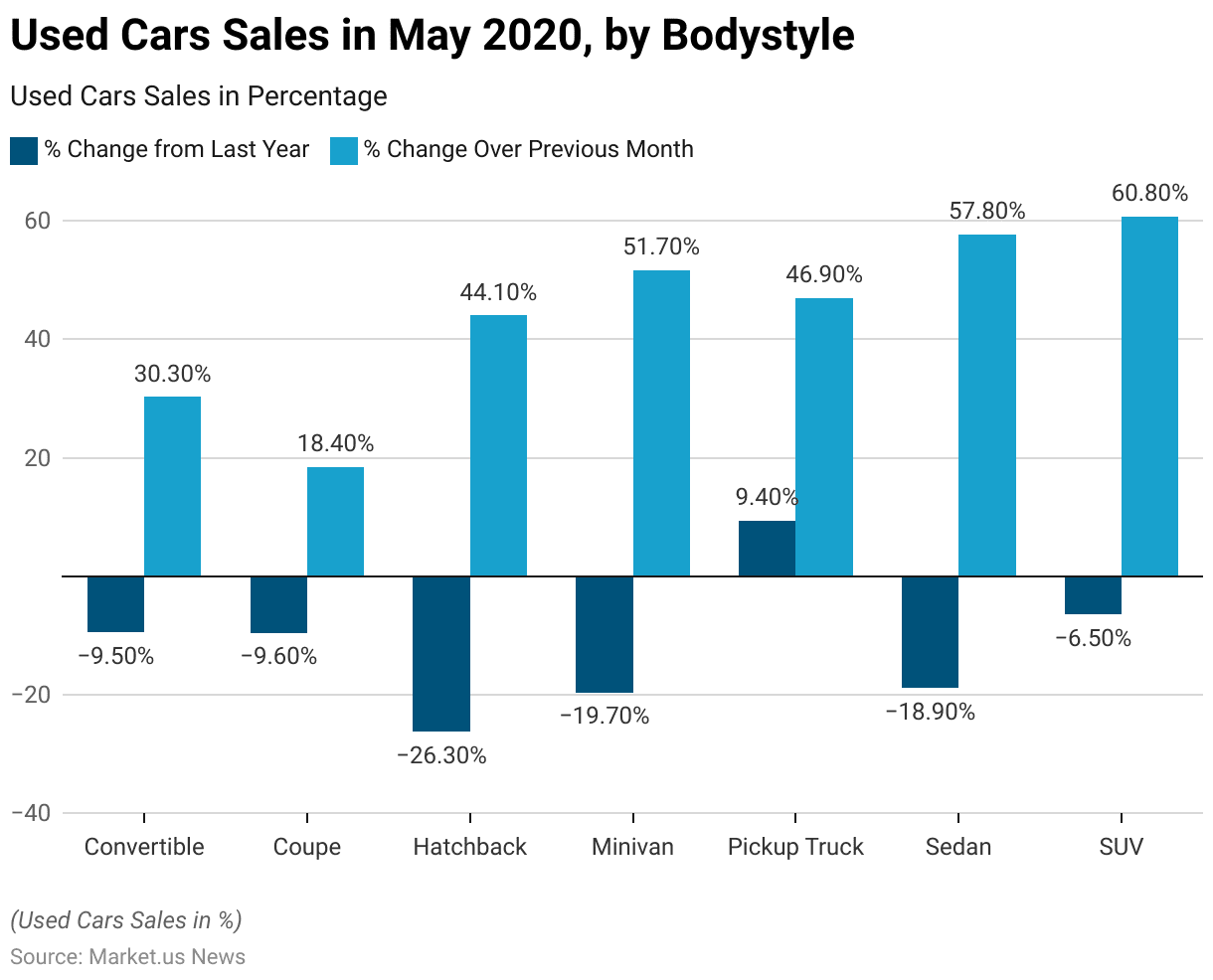
Price Point
- In May 2020, the used car market in the U.S. displayed a diverse range of trends across different price points when compared to the previous year and the preceding month.
- Cars priced at $5,000 saw a positive trend, with a 7.10% increase year-over-year and a 43.70% rise from the previous month. Similarly, vehicles at the $10,000 price point also experienced growth, with a 4.00% increase compared to last year and a significant 77.80% rise over April 2020.
- However, cars in higher price brackets generally saw declines from the previous year but rebounded impressively from the previous month. Vehicles priced at $15,000 declined by 11.30% year-over-year yet surged by 86.90% month-over-month.
- Cars at the $20,000 mark recorded a decrease of 17.80% year-over-year, with a notable recovery of 91.00% from the previous month. Similarly, the $25,000 price point showed a 16.10% decrease from last year but an 89.10% increase from the prior month.
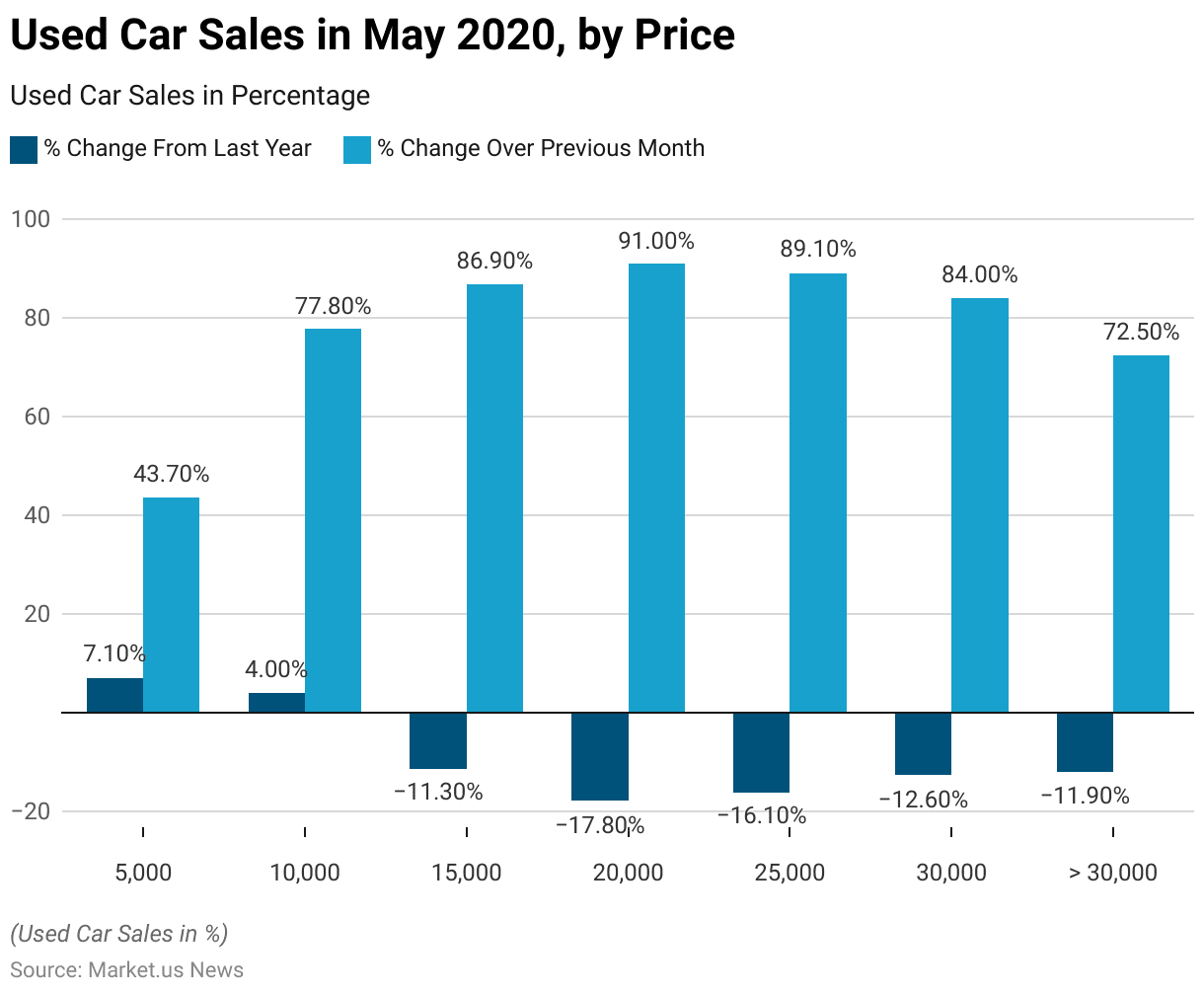
Trends in Average Asking Price and Transaction Price of Used Cars
- The average dealer asking price for used cars in Australia surged past the $40,000 mark, reaching $40,005 in July 2022, according to data released by Cox Automotive Australia’s AutoRadar.
- This marks a substantial 24% increase from the average listing price of $32,073 recorded a year ago and a significant rise from the $26,658 average in July 2020.
- However, despite the higher listing prices, the average delisting (indicative sale) price in July was slightly lower at $35,529 compared to June’s $36,135.
- This resulted in a record gap between the dealer listing price and indicative transaction price, standing at $4,476, surpassing the previous high of $3,983 in May 2020 during the initial onset of the COVID-19 pandemic.
- In terms of volume, newly-added used vehicles in July 2022 totaled 44,127 units, a 4.8% decrease from June 2022. Compared to July 2021, the number of added used vehicles decreased by 4.6%.
Demographics of Used Car Owners
Percentage of Population Considering Purchasing Pre-Owned Cars by Country
- The survey reveals that Great Britain leads among the countries studied, with approximately four-fifths of its population expressing openness to purchasing pre-owned cars, totaling 81%.
- Following closely, around three-quarters of Americans, Italians, and Canadians, at 73% each, also show a willingness to consider buying used cars.
- In other European nations, the trend remains strong, with at least 60% of the population in every country expressing interest in second-hand cars.
- Additionally, about seven in ten Australians share a similar tendency. However, in the Nordic region, Swedes are notably more inclined (70%) compared to their Danish counterparts (61%) to consider purchasing used cars.
- Conversely, developing countries generally exhibit lower percentages of people considering purchasing second-hand cars, though over half of consumers in Indonesia (58%), Mexico (56%), and India (54%) express interest.
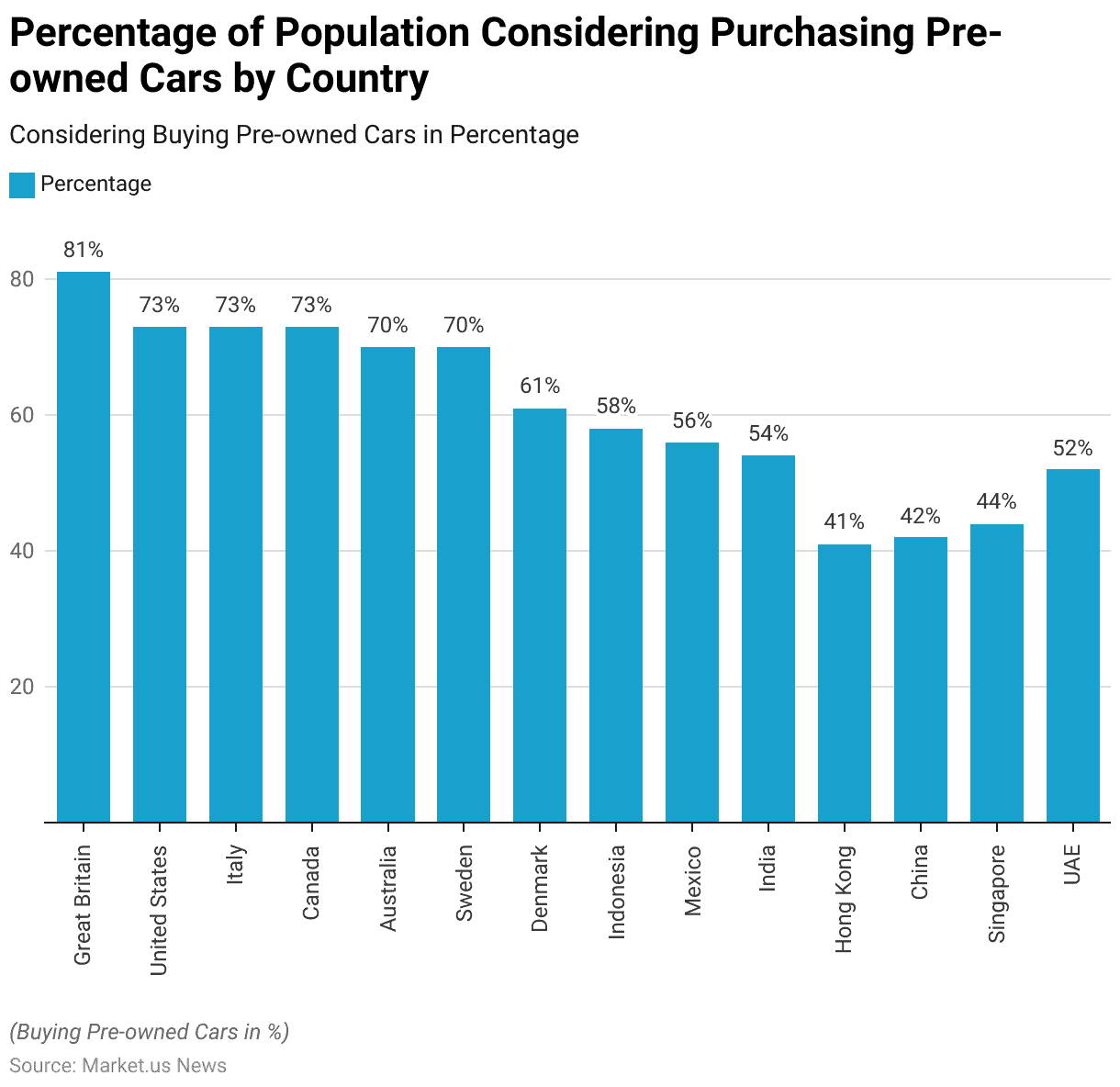
Percentage of Consumers Considering Purchasing Pre-Owned Cars by Age Group
- When examining age demographics, the data reveals interesting trends regarding the likelihood of purchasing pre-owned cars.
- In the United States, older consumers show a higher inclination towards buying second-hand vehicles, with 82% of individuals over 55 expressing openness to this option, compared to 56% of 18-24-year-olds.
- Conversely, in Great Britain, it’s the 35-44 age group that demonstrates the highest propensity for purchasing cars second-hand, with a striking 87% expressing interest, while only 62% of 18-24-year-olds share this sentiment.
Consumer Preferences for Used Cars
- The report, based on research conducted by Close Brothers Motor Finance, indicates that 41% of consumers plan to choose a pre-owned car for their next vehicle acquisition, while 42% intend to purchase a brand-new one.
- Approximately 17% of respondents remain undecided about their next purchase.
- In comparison to data from 2017, there has been a 5% decrease in the proportion of individuals who express an intention to buy a new car.
- There’s a noticeable gender contrast in attitudes toward new and used cars. While half of men (49%) plan to buy a new car for their next vehicle purchase, only a third (35%) of women share this preference.
- Conversely, almost half (47%) of women aim to purchase a used vehicle, compared to just over a third (35%) of men.

Tajammul Pangarkar
Tajammul Pangarkar is a tech blogger that frequently contributes to numerous industry-specific magazines and forums. Tajammul longstanding experience in the fields of mobile technology and industry research is often reflected in his insightful body of work. His interest lies in understanding tech trends, dissecting mobile applications, and in raising a general awareness of technical know-how. When he’s not ruminating about various happenings in the tech world, he can be usually found indulging in his next favorite interest - table tennis.
Latest from Author
- Ready Meals Market Size to Reach USD 297+ Billion by 2033 – Rise with Steller CAGR 7.3%
- Home Improvement Projects Favor Economic Conditions for Homeowners to Access Funds
- GABA (gamma-aminobutyric acid) Market Value to Hit USD 143.6 Million in 2033
- Hydrogen Fuel Cells Market Sales to Top USD 22.7 Billion by 2033 | CAGR of 20.2%
- Water And Wastewater Treatment Equipment Market Value to Hit USD 100 Billion in 2033